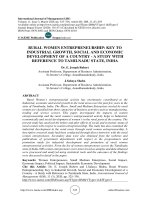Economic growth and economic development 28
Bạn đang xem bản rút gọn của tài liệu. Xem và tải ngay bản đầy đủ của tài liệu tại đây (88.73 KB, 1 trang )
Introduction to Modern Economic Growth
contraction of its GDP per capita, so that in 2000 it is in fact poorer than it was in
1960.
The patterns shown in Figure 1.8 are what we would like to understand and
explain. Why is the United States richer in 1960 than other nations and able to grow
at a steady pace thereafter? How did Singapore, South Korea and Botswana manage
to grow at a relatively rapid pace for 40 years? Why did Spain grow relatively rapidly
for about 20 years, but then slow down? Why did Brazil and Guatemala stagnate
during the 1980s? What is responsible for the disastrous growth performance of
Nigeria?
1.4. Origins of Today’s Income Differences and World Economic Growth
These growth-rates differences shown in Figures 1.7 and 1.8 are interesting in
their own right and could also be, in principle, responsible for the large differences
in income per capita we observe today. But are they? The answer is No. Figure 1.8
shows that in 1960 there was already a very large gap between the United States on
the one hand and India and Nigeria on the other. In fact some of the fastest-growing
countries such as South Korea and Botswana started out relatively poor in 1960.
This can be seen more easily in Figure 1.9, which plots log GDP per worker in
2000 versus GDP per capita in 1960, together with the 45◦ line. Most observations
are around the 45◦ line, indicating that the relative ranking of countries has changed
little between 1960 and 2000. Thus the origins of the very large income differences
across nations are not to be found in the postwar era. There are striking growth
differences during the postwar era, but the evidence presented so far suggests that
the “world income distribution” has been more or less stable, with a slight tendency
towards becoming more unequal.
If not in the postwar era, when did this growth gap emerge? The answer is that
much of the divergence took place during the 19th century and early 20th century.
Figures 1.10, 1.11 and 1.13 give a glimpse of these 19th-century developments by
using the data compiled by Angus Maddison for GDP per capita differences across
nations going back to 1820 (or sometimes earlier). These data are less reliable than
Summers-Heston’s Penn World tables, since they do not come from standardized
national accounts. Moreover, the sample is more limited and does not include
14









